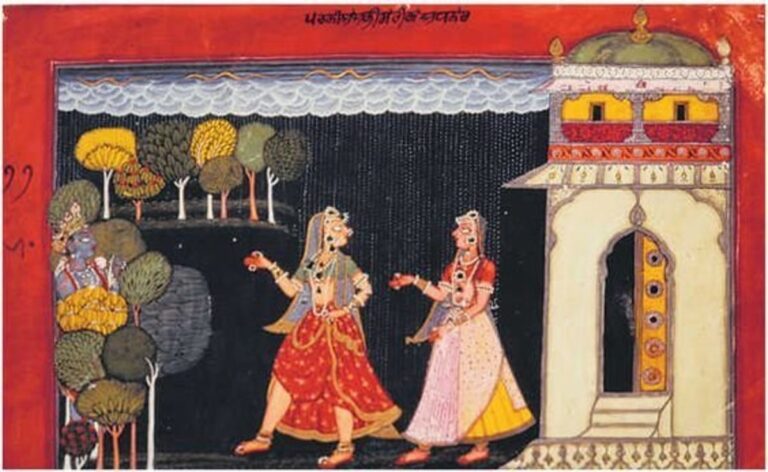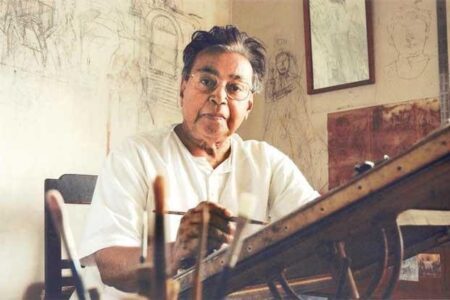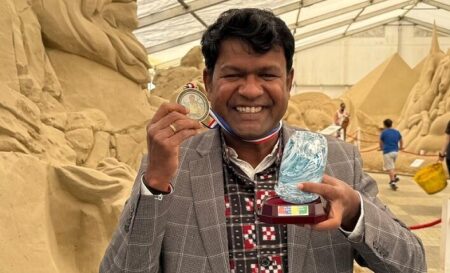The portrayal of Ashtanayikas or eight heroines is one of the most painted themes in Pahari painting.
Did you know that the Nayika occupies a very important place in Indian art and literature? A translation of the word nayika is ‘heroine’. The depictions in art have captured her descriptions in different moods and settings. She is seen in the various situations of love. The Pahari School of art has done full justice to the concept of the nayika as first envisaged in the Sanskrit treatise ‘Natyashastra‘ composed by Bharatmuni on dance and the performing arts, (between 1st century BC and 3rd century AD, with others adding to the main work). Later texts in Sanskrit and Hindi have elaborated on nayikas as well which include Dasarupaka from the 10th century, Sahityadarpana and Bhanudatta’s Rasamanjari from the 15th century and Keshavdas’ Rasikpriya of the 16th century, a work of poetics on love poetry in Hindi. Kalidasa’s works and Gita Govinda of 12th century by Jayadeva reflect the nayika concept too.
Natyashastra and the Nayika
The Natyashastra elucidates the rasa theory. In Indian aesthetics, a rasa literally means ‘nectar, essence or taste’. A nayika’s beauty is very much a part of the shringara rasa which includes the amorous, the erotic, the decorative, and even song and dance. The heroine forms the central character in many works of Indian literature. Through the work, one can experience her different moods and emotions, her challenges, her failures and her victories. The description of her beauty and character also makes it interesting to read and understand the social environment of a given era.
A nayika brings out the best in a poet or dramatist, by lending her presence by illusory, historical or real presence. Bharatmuni has classified eight types of nayikas called ashtanayikas. This theme has been well used in painting, sculpture, dance and drama. Bharatamuni has focussed on the nayikas as she can appear in a given drama again depending on the plot. Though the term nayika can encompass many types of nayikas in many facets and contexts, the various states of the nayika in love are depicted in drama. The subject of classification is called nayika-bheda. The different nayikas are the Vasakashajja, Virohotkanthita or Utka, Svadhina-bhartruka, Kalahanatarita, Khandita, Vipralabdha, Proshitabhartruka and Abhisarika.
Nayika in the Pahari School
The nayika did not remain a drama queen. The concept of nayika was taken from the music-dance-drama platform to the realm of paintings. The Pahari Schools of painting which include Kangra, Guler, Basohli, Chamba, Nurpur, Garhwal and Mandi among a few others which flourished from princely states in sub-Himalayan India have specially focussed on the nayika theme during the 17th to 19th centuries. It was during the rule of Raja Sansar Chand of Kangra (r.1775-1823) that many such paintings were made and many texts like the Jayadeva’s Gita Govinda and Keshavdas’ Rasikpriya got beautiful illustrations. There have been famous artists from the Pahari Schools like Manaku, Nainsukh, Molaram, Devidasa among others.
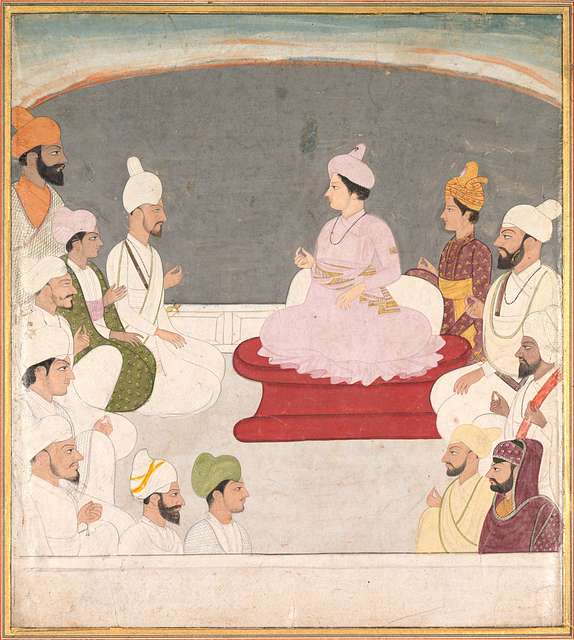
The Kangra nayika is fluid in movement, surrounded by nature. The elements of nature are captured in rich colours. The nayika could also be forlorn, sitting in a forest with the background in softer shades. The Nurpur and Basohli works use bright colours with the women gorgeously dressed.
There is a nayika in every woman. Especially when she is in love. Human feelings of eagerness in love, anger, separation, estrangement and disappointment are all expressed through these miniature paintings. The divine couple with Radha as nayika and Krishna as her nayaka (meaning hero) has been very popular in Pahari paintings.
Let us take a look at some of these beautiful nayika depictions from the Pahari Schools of miniature painting of India.
Portraying Ashtanayikas
Vasakashajja means one who is dressed up for union. She is depicted below in a painting readying her shajja or bed and is full of longing and waiting for her lover. Bhanudutta in Rasamanjari describes such a nayika:
‘She put on all her jewellery,
Perfumed her thick head of hair,
And at her bedside had them place areca nut and betel leaf.
And the bedroom, when the woman
entered, her body all aglow,
was a darkened overcast day
set ablaze by golden ketaki flowers’
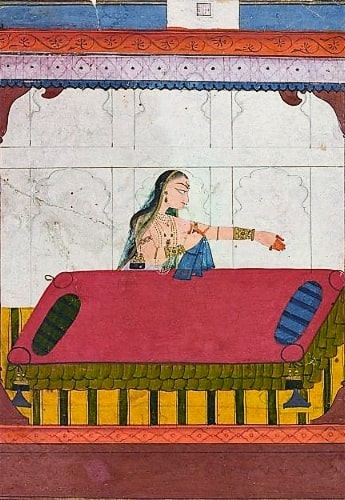
One who is distressed by separation is Virohikanthita or Utka, a nayika who is expectant and is pining for her lover who has failed to meet her or come home due to preoccupation. She is utterly disappointed. Her thoughts as envisaged by Keshavadasa in Rasikpriya –
kaidhon gṛha kāja kai na chūṭata sakhā samāja kaidhon
kachu āja brata vāsara bibhā bhāta tain
‘Is it because of some work at home? Or is it because he does not leave a company of friends or
is today some fast-day of his?’
A nayika is a svadhinabhatruka if she is one who has subjugated her lover. He listens to her, applies mahawar, a lac dye on her feet, vermillion on her forehead. Radha has been portrayed as such in illustrations of ‘Geeta Govinda’. Such a nayika is happy and proud.
Bharatmuni says –
surataatirasair baddho yasyaa parshve tu nayakah
saandraa moda guna prapta bhavet swadheena bhartrukaa
‘Through her love and other characters, she who has attracted her beloved to
be by her side at all times is known as swadheena bhartruka nayika.’

Kalahanatarita is a nayika who is separated or angry with her lover due to quarrel. Sometimes she is separated due to her arrogance. In this state her lover is usually shown pleading with her, or leaving her house dejected. She might also be shown refusing his advances. The nayika is however repentant without him. Bharatmuni describes her thus –

irshya kalaha nishkraanto yasyaa naagachhati priyah
saamarshavasha sampraaptaa kalahantaarita bhavet
‘She, whose lover is separated from her due to jealousy and quarrel, is known as kalahantarita nayika. She is sorrowful at her situation.’
Khandita is a nayika who is enraged with her lover because he has not come to her and probably spent his time with another woman and she is angry with him. In this state she is depicted as offended and rebuking her lover. Bharatmuni says –
vyaasangaaduchite yasyaa vaasake naagatah priyah
tadanaagama dukhaartaa khanditaa saa prakeertitaah
‘One whose beloved has not come to her and enjoys with another woman is
known as a khandita. She is distressful and angry.’
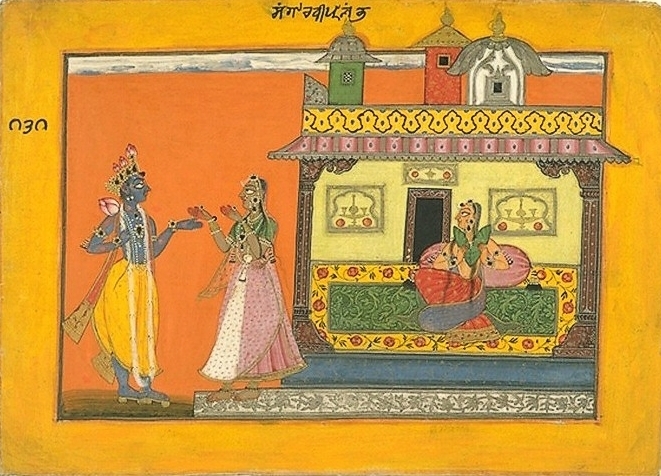
Vipralabhda is a nayika who is a deceived heroine, one who has waited for her lover, she is usually depicted throwing away her jewellery. She is disappointed and her heart is full of discontent. Bharatmuni says of her –
yasyaa doorim priyah preshya dattaa sanketameva vaa
naagata kaaraneneha vipralabdhaa tu saa bhavet
‘Even after sending messages, she whose beloved does not show up is known as vipralabdha. She feels sad and humiliated.’

Proshita–bhartruka is a nayika who has a travelling lover and who does not come back on the expected day. She is depicted seated alone or surrounded by her maids and is inconsolable. She does not bother to dress up or apply any make-up or comb her hair. Bharatmuni says of her –
gurukaaryaantara vashaad yasyaa vai proshita priyah
praroodhaalakakeshaantaa bhavet proshita bhartrika
‘One whose lover has left to another place for an important business is
known as proshita bhartrika. She is depicted as a lady who has abandoned her
ornaments and left her hair loose.’
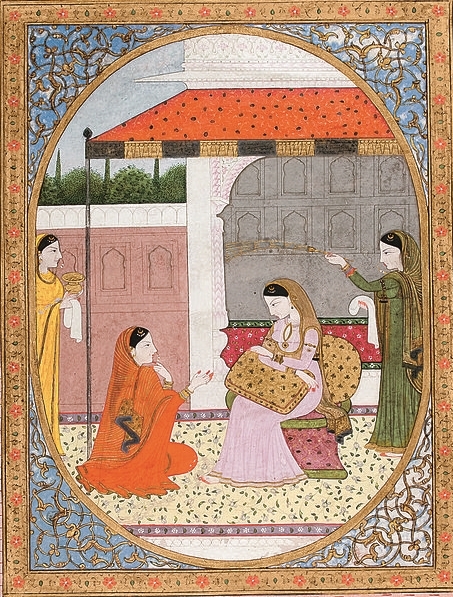
Abhisarika is the nayika who moves, to meet her lover secretly. She is shown facing dangers on her way like snakes and animals in the forest and thunder-storms. She is often shown as starting from the door of her house, in a hurry to reach her destination. She just wants to meet her lover who is waiting for her. Bharatmuni says of her –
hitvaa lajjaantu yaa shlishtthaa madena madanena vaa
abhisaarayate kaantam saa bhavedabhisarika
‘Overwhelmed with love, she who leaves behind her family and shame to go and meet her beloved is to be considered as an abhisarika.’
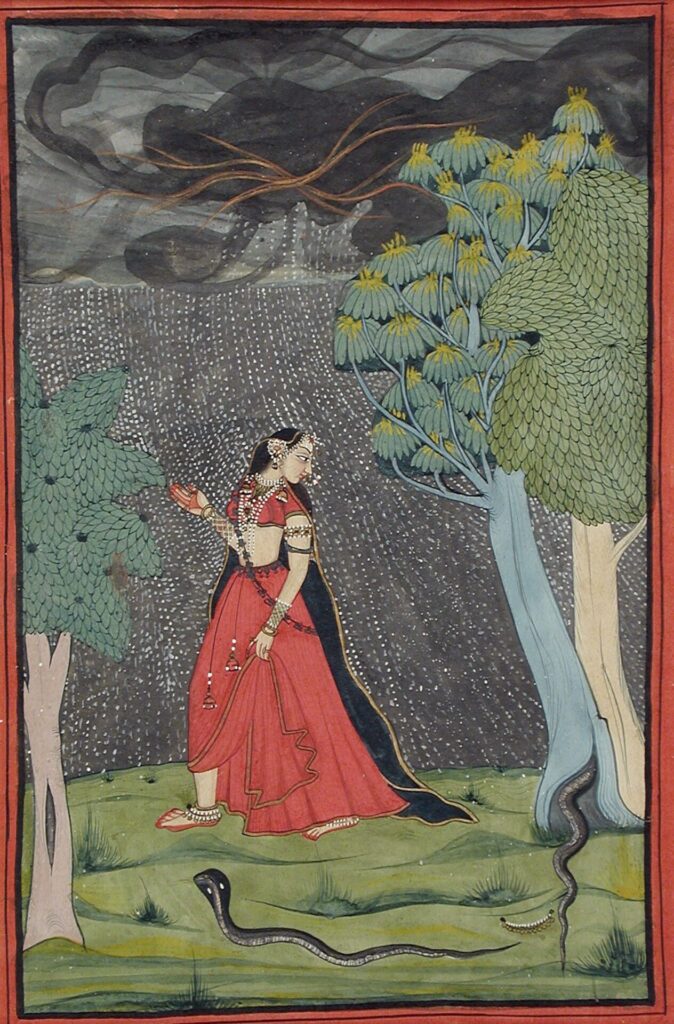
The concept of the eight depictions of the nayikas have not changed and women still go through these emotional states in different stages of love. The social context might change but the bhava or feeling is timeless.

